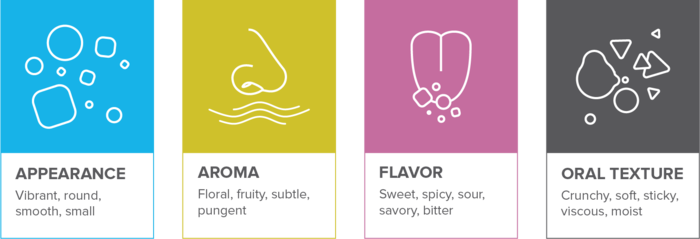The Sensory Experience of Food and Descriptive Sensory Evaluation

Our favorite foods evoke a complex interplay of sensations. The velvety texture, the spicy kick, the nostalgic aroma – each element contributes to our overall enjoyment. Sight, smell, taste, and touch are the most obvious senses involved, but even sound (a crisp cracker, fizzing soda) impacts our perception. These sensory experiences shape our food preferences, making it crucial for food manufacturers and marketers to understand the nuanced characteristics of their products. This understanding is achieved through descriptive sensory evaluation.
What is a descriptive sensory evaluation?
Descriptive sensory evaluation provides a detailed sensory profile of a food product, quantifying the intensity of each attribute. Highly trained panelists analyze key sensory descriptors, offering both qualitative descriptions and quantitative intensity measurements. This comprehensive approach helps manufacturers understand their product's sensory characteristics and how they might be perceived by consumers.

Descriptive Sensory Evaluations
Medallion Labs has experts in documenting the flavor and texture characteristics of consumer food products. Contact us today for help choosing the right sensory evaluation for your needs.
Contact UsLet's Get to Work!
Submit your order online and ship your samples today. If you have questions, we are always here to help.
Medallion Labs+
A food testing program designed with mid-market and enterprise food and ingredient manufacturers in mind.
When to Conduct a Descriptive Sensory Evaluation
Sensory testing is valuable at various stages of food production:
- Research and Development: Understanding consumer preferences during product development.
- Quality Control: Ensuring consistent sensory quality across batches.
- Product Comparison: Comparing sensory attributes of different products or formulations.
- Shelf-Life Studies: Monitoring changes in sensory characteristics over time.
Sensory Evaluation Methods: A Comparison
Several methods exist, each with its strengths and weaknesses:
Flavor Profile Method
- Origin: Developed by scientists at Arthur D. Little in the 1940s.
- Description: Analyzes flavor using five components: character attributes, intensity, order of appearance, aftertaste, and amplitude (overall impression). A small, highly trained panel (4-6 members) evaluates the product individually, then collaboratively determines a consensus profile.
- Scale: Initially a 5-point scale, now often expanded to 14 points for greater precision.
- Recommended for: Research and development, product comparisons, defining product attributes, quality control, shelf-life studies.
- Advantages: Small, trained panel focused on flavor.
- Disadvantages: Potential for bias from dominant panel members.
Texture Profile Method
- Origin: Developed by Dr. Alina Surmacka Szczesniak and her team at General Foods in the 1960s.
- Description: Uses a standardized lexicon and procedures for objective, repeatable texture evaluations. Often utilizes instruments like the General Foods Texturometer to quantify texture parameters.
- Parameters: Five core parameters (hardness, cohesiveness, adhesiveness, viscosity, elasticity) and three secondary parameters (brittleness, chewiness, gumminess).
- Recommended for: Research and development, product comparisons, defining product attributes, quality control.
- Advantages: Easy to conduct, unbiased results (with instrumentation).
- Disadvantages: Operators may accept results without sufficient test refinement.
Spectrum Descriptive Analysis
- Origin: Developed by Gail Vance Civille in the 1970s.
- Description: Combines rigorous training and structure of Flavor and Texture Profile methods, using a larger panel (up to 15 people) and a refined scale (typically 150 points). Statistical methods are applied to the data.
- Recommended for: Research and development, product comparisons, defining product attributes, quality control, shelf-life studies.
- Advantages: Trained panel, comprehensive product analysis.
- Disadvantages: More time-consuming and costly than other methods.
Quantitative Descriptive Analysis (QDA)
- Origin: Developed by Tragon Corporation in collaboration with UC Davis.
- Description: Capitalizes on panelists' skill in making relative judgments. Uses a line scale (e.g., 6 inches with half-inch intensity markers) for quantifying attributes. A panel of 10-12 people participates.
- Recommended for: Research and development, product comparisons, defining product attributes.
- Advantages: Aggregated analysis, intuitive data outputs.
- Disadvantages: Data variance based on panel participants.
Free-Choice Profiling
- Description: Uses untrained consumers who provide "liking" or "acceptance" responses rather than empirical ratings. Responses are aggregated to form a consensus.
- Recommended for: Research and development, product comparisons.
- Advantages: Quick, inexpensive, provides insight into consumer perceptions.
- Disadvantages: Inconsistent lexicon, varying interpretations of attributes.
Choosing the Right Method
Selecting the appropriate sensory evaluation method depends on your specific needs, budget, and the stage of product development. Consider the level of detail required, the resources available, and the type of information you need to obtain.
Medallion Labs Sensory Evaluations
Medallion Labs specializes in Spectrum Descriptive Analysis, focusing on documenting flavor and texture characteristics of consumer food products. They offer expertise in selecting the right sensory evaluation method to meet your specific needs.